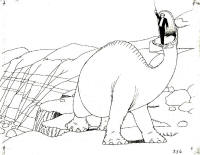I was digging around the internet one evening when I stumbled across a book called "
American Playwrig hts of Today
hts of Today". Of course, today was really a reference to the 1930's so I had to shift my perception of time back a bit. What caught my attention was that the book referenced a gentleman who was born in
Muskegon in 1894, who "drifted into theater, with which both his parents had been connected." His name was John McGowan.
Of course, my recall of the surname, and its tie to
Muskegon comes from
the restaurant that once was located at the "end of the trolley line" back in the days of the Actors' Colony.In addition, in the biography of Keaton co-star and
former colony member, "Big Joe" Roberts, their is also a reference to a McGowan.
In 1914, Roberts and his wife (Lillian Stuart) teamed with Johnnie McGowan, for another tour of "On the Road." McGowan was renowned as a singer, performing "You Were Made to Love" and "You Have Something I Want."
Could Johnnie McGowan be John McGowan?
Well, the time fame certainly fit.
More digging turned up additional detail on the career of Mr. McGowan. At the University of Wisconsin Digital Collections, I discovered that McGowan had donated papers covering his career as an actor, playwright and director. In addition,
I found a brief biography.
John McGowan was born on January 12, 1894 in Muskegon, Michigan. He ran away from home when a freshman in high school, making his way to Flint Michigan, and then to Chicago, where he became a singer of illustrated songs for ten dollars a week.
There followed short stints in a two-act with a vaudeville actor and in the chorus of The Winning Miss. The producer of that show kept McGowan for three years in a series of tabloid shows for which he wrote many of thee jokes and songs. After developing a great desire to write for the theatre, McGowan realized that he had to catch up on his reading of the classics in order to fill the serious gaps in his knowledge.
In Danville, Illinois, in 1913, he met Howard Gale, advance-man for the Cohan and Harris road company of Officer 666 (a stage comedy from 1912) . Gale invited McGowan to come to New York to meet George M. Cohan when his present contract expired in June, 1914. Unfortunately, at nineteen, McGowan was simply too young to fit the part which Cohan, 36, had written originally for himself.
McGowan would later sign a three year contract with
Florenz Ziegfield. He would later renew his association with Cohan, while writing for vaudeville, and soon after, Broadway.
From a book title,
The Days We Danced, by Doris Eaton Travis, I learned that McGowan was a "red-headed Irishman with big blue eyes" would would move on to Hollywood, working for MGM under the name Jack McGowan around 1933. The
Internet Movie Database site lists his extensive credentials.
According to a newspaper reference, McGowan married Betty
Wyman on January 1, 1938. The former Elizabeth Calvin, became well-know to the public as the Lucky Strike girl. She would later appear in the Hollywood production "
Vogues of 1938".
While in Hollywood, McGowan would work on adapting some of his Broadway success for the big screen. This included Girl Crazy, a 1930 musical he co-authored with Guy Bolton. The movie version, released in 1943, starred Mickey Rooney and Judy Garland. In 1947, a McGowan story "A Tree Grows in Brooklyn" was scripted for film Isobel
Lennart. The cast included Frank Sinatra, Kathryn
Grayson, Peter
Lawford and Jimmy Durante.
To date, I've found little more on McGowan's career.
It appears that he
passed away in 1977.Anyone out there able to fill in more details?













![[winsor.gif]](http://www.actorscolony.com/winsor.jpg)